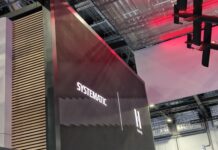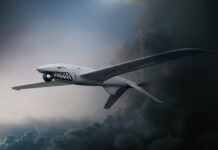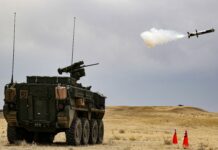Developments in the dismounted soldier systems of several countries were revealed at the SAE Media Group’s Future Soldier Technology Conference in London in March 2024, with particular emphasis on system integration, mounted/dismounted interoperability and the introduction of innovative and disruptive technology. Since the end of the conference there have been contract awards that have confirmed project intentions briefed by different speakers.
UK
The British Army has two separate but linked programmes: dismounted close combat (DCC) and dismounted situational awareness (DSA). The latter covers communications and battle management systems (BMS); the former addresses all the other elements.
Speaking at the conference, Colonel Paul Cummings, DCC portfolio leader at the UK MoD Defence Equipment and Support (DE&S), identified several major projects to upgrade or replace DCC capabilities.
The Virtus integrated helmet, body armour and load carriage system including the tactical ballistic plates is to be recompeted, although Col Cummings did not anticipate any great changes in the fundamental designs. However, a particular focus of this project is an effort to provide better fitting for female personnel. Col Cummings noted that because women were now eligible for all close combat roles and because in future the equipment will be issued to all user groups, good fitting for both male and female physical characteristics was important.
Following on from Project Hunter, the recent acquisition of new Alternative Individual Weapon (AIW) for the Army’s Ranger Regiment and for the Royal Marines, Project Grayburn will address the replacement of the existing SA-80. Project Hunter resulted in the selection of the Knight’s Armament Company (KAC) KS-1, together with advanced sights and a suppressor.
The concept phase for Grayburn will begin in latter part of 2024, with engagement with industry commencing towards the end of the year. Col Cummings noted that the overall requirement was for 170,000 weapons across UK defence and it was likely that there would be different variants of the weapon with commonality of operation. He said that the aim would be to achieve a procurement model that resulted in a steady flow of new weapons each year, developing a relationship with manufacturers that “allows us to explore upgrades, technology insertions and other developments. I would not expect the 170,000th weapon to look exactly like the first”.
As a result of the development in the use of uncrewed aerial vehicles (UAVs) in Ukraine and their increasing ubiquity both for surveillance and to deliver effects, in common with other countries the Army is also focussing on counter-UAV (C-UAV) capabilities in its revitalised Land Ground Based Air Defence (L-GBAD) programme.
Col Cummings outlined the plans to provide C-UAV at section level. The Army has recently acquired the SMASHX4 Smart Weapon Sight which provides a hard-kill capability. This is to be followed by a detection and non-kinetic capability which will be known as Electro-magnetic Detect and Defeat (EMDAD).

Credit: Smartshooter
At the end of March 2024 the MoD issued a tender notice for EMDAD, which will be procured under a multi-year, multi-supplier framework agreement, with the aim of deliveries commencing by the end of July 2024 for trails and evaluation. When speaking at the conference Col Cummings emphasised that the programme would embrace “catalogue of options to meet new requirements or threats as they arise. It will not be large quantities of a single system as we need to be able to defeat the latest or theatre specific threats. The framework will allow us that agility with a little but often approach.”
While the UK’s DCC stand seems to be making progress, the picture on the DSA front is less rosy, with the programme described by Lt Col Gareth Davies, SO1 Combat Systems and Bearers as “not in a great place at the moment”.
He described DSA as “an Official Sensitive meshed radio network with chest mounted devices providing voice and data communications for dismounted infantry. It will provide the foundation for the ‘Soldier as a Platform’ system upon which all subsequent elements of the integrated soldier system will be built”.
This is a description that could apply to most dismounted soldier systems, and as in other programmes DSA consists of a communications device and a headset, and for commanders an end user device (EUD) and a soldier electronic architecture.
Lt Col Davies explained that a comprehensive experimentation programme “has taught us a lot” but it had equally thrown up several challenges. Currently there were two experimental versions of the DSA system, one using meshed radio, a hub, an EUD and a power source, with the other using an LTE smartphone and an external power pack. He said that opinions were now divided as to which communications means to adopt, with both having advantages and disadvantages, and this was delaying the programme’s progress.
Lt Col Davies noted that the DSA requirement had been formulated some time ago, so there was a challenge in working out “how to update [it] to take into account new technology while simultaneously proving the requirement is right”.
He added that an associated challenge was the dichotomy between a standalone project providing situational awareness (SA) and command and control (C2), and the integration of other sensors and systems. Additional capabilities were continually emerging that could use the hub or EUD and that required power, but these were not part of the basic DSA requirement although they did contribute to the soldier as a platform concept.
At present the plan is that initial operational capability (IOC) will deliver a standalone capability and enable operation as singular company groups. Integration of additional systems will be added in the progression to full OC and beyond. However, this is another aspect that is under review as to whether this is the right approach.
This has all impacted the next stage of procurement, Lt Col Davies said, particularly the radio competition, and although the funding was allocated, approval to spend it had not been granted. “We have to work through all of these issues”, he said.
US
Lieutenant Colonel Christian Hasbach, product manager soldier manoeuvre sensors US Army, highlighted several capabilities of the US Army’s Nett Warrior system programme that had recently been introduced or were imminent.
Amongst these was the dismounted operators combat kit – ultra (DOCK-U) from Kagwerks, a chest mounted three-port hub and display mount which is EUD agnostic, MANET radio agnostic, contains a data radio card, and provides on-body computation and a wireless personal area network. He said the impact of using the DOCK-U was to reduce the overall size weight and power (SWAP) of the system and minimise cables and complexity for the user.
In order to avoid users constantly looking at chest-mounted EUD, a haptic-enabled wrist-wearable device is being added to Nett Warrior. Initially a Garmin Tactix Delta which will in future be replaced by a Samsung smart watch, the device is integrated with the Android Tactical Assault Kit (ATAK) software with a plugin and via Bluetooth. It provides haptic feedback notification of geofence alerts, chat messages, route navigation and emergency messages, and can also provide standard message responses to ATAK chat messages. Additionally it can provide user physiological metrics, such as heart rate, core temperature and heat stress index, that can be fed back over the network.
Lt Col Hasbach also highlighted other ATAK plugins: Trailblazer, a route planning application; a radio over IP push-to-talk translator; Unmanned Systems (UMS) Tools, which is an effort to create applications for controlling and tasking uncrewed platforms from Nett Warrior; and Tactical Readiness Asset Key-terrain Reconstitution (TRAKR), which enables personnel and materiel to be tracked in real time during deployment outloads and was created in response to a lack of visibility in 18 Airborne Corps of the outload progress.

Credit: USAF
He also noted the development of Foresight, a web-based dashboard that shows on-soldier sensor status, enabling commanders at platoon and company level to monitor and diagnose personnel network, electronics and software status, plus location and physiological state.
Canada
The Canadian Army’s Individual Soldier System Project (ISSP) is entering its third cycle of development, building on the successes and lessons learned from the previous two cycles.
Major Gabriel Benoit-Martin, project director ISSP, explained that Cycle 1, consisting of a radio, EUD, hub, power supply and a proprietary BMS provided a baseline capability with over 4,000 systems fielded. It was a big step forward, he said, particularly in providing SA, but the system was not fully accepted by the field force for a number of reasons including weight, latency, cable management, difficult navigation software and an inability to interoperate with allies.
Cycle 2 was lighter, less bulky and more modular. It included a new radio, the Harris AN/PRC-163 which allows interoperability with secure Type1 networks and with the Canadian Light Armoured Vehicle (LAV); integration with a new laser range finder; a smartphone-based EUD; and ATAK as the BMS. Cycle 3, which is now being fielded, provides a technical refresh and moves to a commercial off-the-shelf (COTS)-based approach, with a new hub; a new EUD, the Samsung S20 Tactical Edition; a new L3Harris radio using the Trellisware TSM MANET waveform; and will shortly include a new battery. Maj Benoit-Martin said that the adoption of MANET would alleviate some of the communications challenges that had previously been encountered.
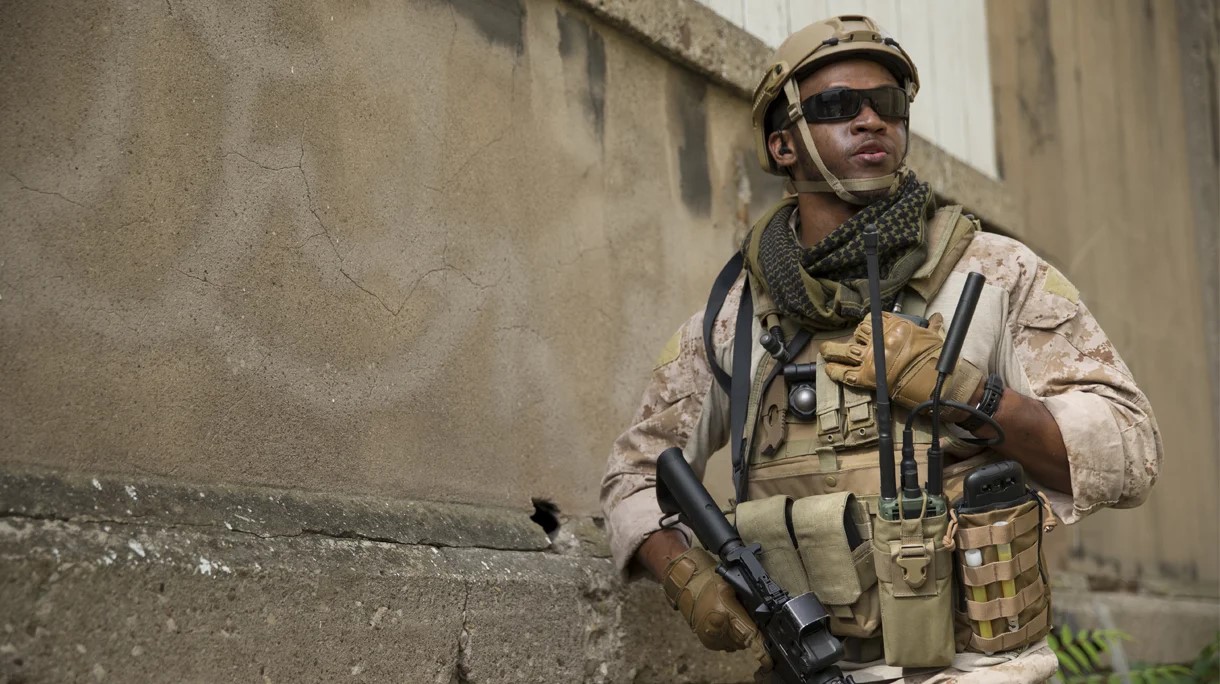
Credit: L3Harris
Nearly 3000 Cycle 3 systems are being fielded to light infantry, mechanised battalions and supporting arms in three different configurations of increasing capability: Soldier, Assaulter and Commander. Soldier consists of a radio, central battery, hub and headset and essentially provides secure but unclassified (SBU) voice communications and SA data upwards. The battery and hub can be discarded to reduce weight.
The Assaulter configuration, for team commanders, section second-in-commands, and some specialist roles adds an EUD giving access to the ATAK BMS. Commander, for section commanders and above, adds access to a second radio and Type 1 secure communications, vehicle integration, and connection to multiple accessories.
Major Benoit-Martin said that the concept of employment for ISSP was still being developed as users became more confident of the system and its capabilities. Technology refreshment will continue.
New Zealand
Lieutenant Colonel Paul Cocker, NZ Defence Force (NZDF), said that the NZDF was building a unified digital backbone for the NZ Army and that developing a soldier system was an integral and early part of this. He described the existing system as “a greenfield” site, with a tactical communication and information system (CIS) that had not been updated since 2003, and in which information was passed “at the speed of talking”.
The NZ soldier system is based around the L3Harris Falcon IV radio family; the Systematic SitaWare HQ, Frontline and Edge C2 software suite plus ATAK for battle management and additional integration software from Stauder; and headset and system connectivity solutions from Invisio and Glenair respectively.
Lt Col Cocker said that with the advent of the system work was continuing on developing tactics, techniques and procedures (TTPs). Apart from the improvements to dismounted planning and execution and tempo the benefits were particularly noticeable at the “1-up and 2-up” levels of command. There was a significant reduction in cognitive load for commanders through the improvement in SA and the reduction of the fog of war, he said.
He noted that the NZDF had been a SitaWare user since 2009 and the software provided seamless vertical passage for data, but this was less true for horizontal passage with allies. He observed that it was important to recognise that there would be trade-offs between the two approaches and to identify the interoperability points in the network and the need for gateways.

Credit: Systematic
The programme is equipping one company at a time, and Lt Col Cocker said that a challenge was deciding how the programme would be scaled across the combat and combat support arms. The next steps in the programme will also include mounted/dismounted integration with the NZ Army’s new Bushmaster vehicles and exploring joint and combined networking.
Germany
There are two strands to the Bundeswehr’s dismounted soldier programme. The existing system, the Infanterist der Zukunft (IdZ; ENG: Infantryman of the Future) is based on the Rheinmetall Electronics (RME) Gladius soldier system, which replaced an earlier version from Airbus. It is currently in its second generation (Gen 2), a version developed for the German contribution to the 2023 NATO VJTF task force, known as IdZ-ES (Erweitertes System; ENG: Extended System) and specifically intended for the System Panzergrenadier, the integration of the dismount with the Puma IFV.
It is a more modular system consisting of a Tectonica Bantam USB power and data hub; a Bren-Tronics power source; a Getac MX50 tablet as the EUD; and a CeoTronics CT-MultiPTT 3C central operation and control unit that can simultaneously co-ordinate up to three independent communication circuits, plus an additional press-to-talk (PTT) on the weapon. Communications are provided by the E-LynX PNR-1000 for all users plus the Rohde & Schwarz handheld radio as a rear link for commanders. The BMS is Rheinmetall’s TacNet software, with a software gateway providing the interface for the passage of data between TacNet and SitaWare Frontline, which is employed by mounted users.
A total of 3,600 IdZ Gen 1 systems were provided up to 2020, and 900 of these were upgraded to the IdZ Gen 2 standard by 2023. Speaking at the conference, Sebastian Miekley, business area coordination for digitalized land systems at Rheinmetall Electronics, said that the upgrade of the remaining 2,700 Gen 1 systems was planned. He added that Rheinmetall Electronics was also working on its offer for IdZ Gen 3, which might include modernisation of the C2 equipment and the head system and upgrade of the optical and aiming devices, although he did not go into specifics.
IdZ Gen 3 is linked to the Bundeswehr’s Digitisation of Land Based Operations (DLBO) programme, the goal of which is to ‘enable network-centric warfare at the mobile tactical level’, according to Dr Sebastian Gies, project lead soldier system D-LBO, Federal Office of Bundeswehr Equipment, Information Technology and In-Service Support (BAAINBw).
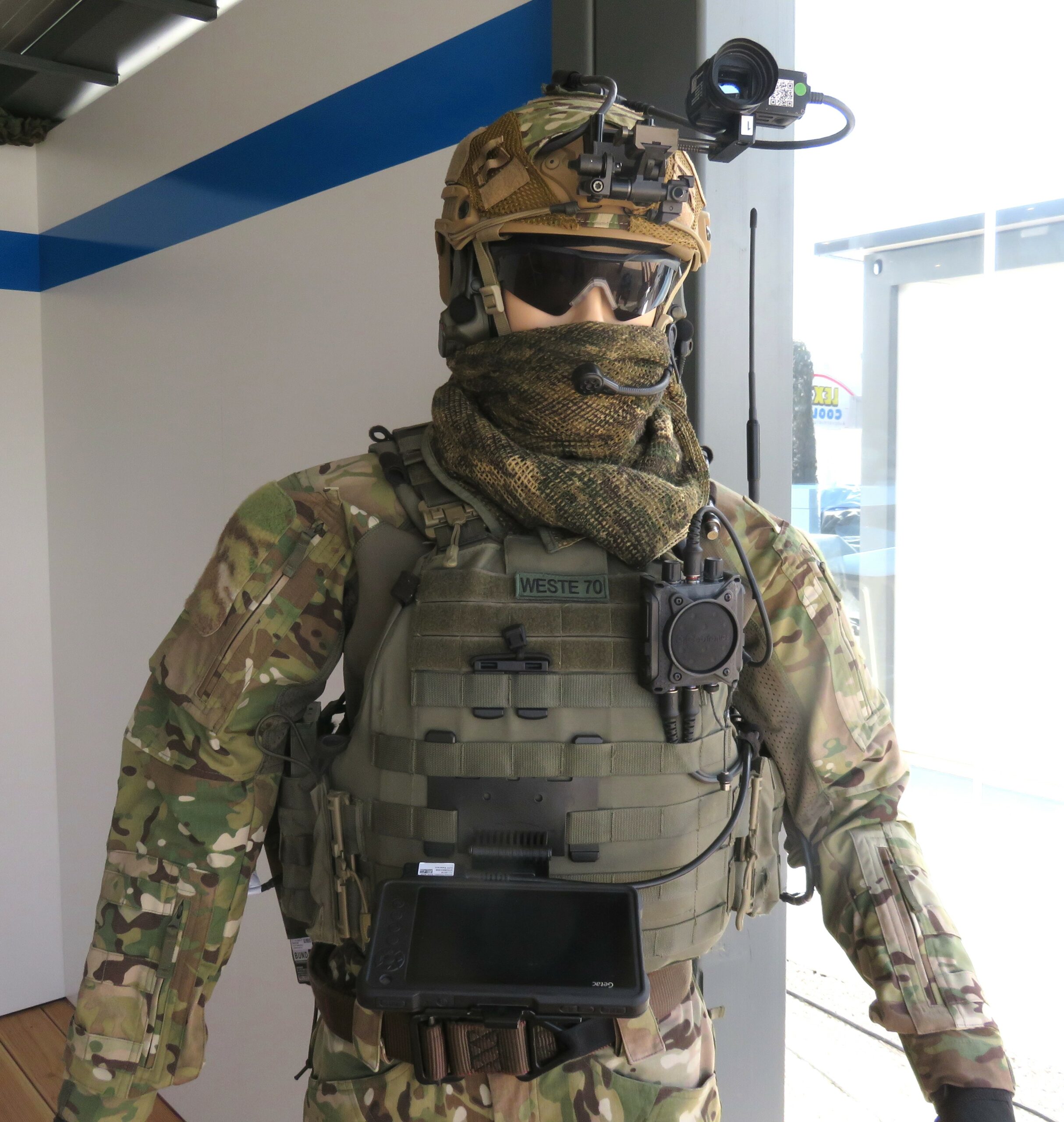
Credit: Giles Ebbutt
DLBO will provide a ‘robust, scalable, tactical IP network’ consisting of mobile tactical nodes (MTN) and mobile tactical clients (MTC), which will operate agnostic and transparent to the bearers and will embrace the entire force, with the existing System Panzergrenadier and IdZ an integral part.
Dr Gies said that as part of the DLBO development process the DLBO soldier system was still being defined, but would consist of a helmet; ballistic vest; headset and hearing protection including PTT; EUD; MTC core software; a hub; power source; cabling; communications; and vehicle connectivity. The system would be scalable, modular and can be tailored to the needs of the different branches of the Bundeswehr.
He explained that development will be in three stages: a demonstrator, a pre-production model, and roll out. The demonstrator phase will identify the optimal positioning for components, refine variants and provide proof of principle of the design through laboratory and field tests. The former took place in late 2023 and the latter is scheduled for July 2024, and Gies said that soldiers have been included in the process from the beginning.
The pre-production phase will test the refined design on a bigger scale and expose any further issues. The system will then be fielded in different configurations for the different branches, and it will then be subject to further spiral development and capability improvement.
Gies said that component vendors would be identified during the pre-production phase and it was likely that competition would start in the second half of 2025. Having said that, in late April 2024 RME was awarded a contract worth up to EUR400 million to supply up to 191,000 sets of headset and hearing protection including PTT, with 3M Peltor providing its ComTac VIII headset and CeoTronics its 1C and 3C CT-Multi PTTs. This would seem to preclude a competition for this element of the system.
Hungary
The development of Hungary’s dismounted soldier system is part of the Hungarian Defence Force (HDF) digital transformation process, which embraces the entire organisation. Speaking at the conference, Colonel Ákos Tajti, director, capability development office, HDF, said that the HDF was still working to define its needs, with doctrinal questions still unclear and the capability requirement as yet not substantiated. He noted that integration with the Lynx IFV, which he described as the HDF’s flagship project, was a key aspect.
He said that system development was proceeding on two parallel tracks. A company’s worth of Elbit’s Torch-X system had been procured for experimentation, with different soldier and commander configurations. A dismounted BMS was a separate national development, and integration with the HUNTACCIS BMS project led by the Hungarian HM EI consortium is fundamental.
Continuing lines of development cover dismounted software (SA, BFT, energy management and radio connections); hardware (central unit capabilities); and vehicle connectivity and integration with vehicle system. Col Tajti said that the software had to be as simple to use as possible with a ‘3-click’ rule, and with functionality harmonised for the user role.
He added that there were four areas of innovative technology that the HDF was also addressing which would impact dismounted systems: autonomy, particularly for UAS; energy supply and management, including novel fuel cells and hydrogen; positioning in a GNSS-denied environment; and artificial intelligence (AI).
Giles Ebbutt




![The Pentagon’s new ‘Project Linchpin’ could shake things up US Army Maj Eric Sturzinger, assigned to Artificial Intelligence Integration Center, gives a capability brief during for Project Convergence at Yuma Proving Ground, Arizona, on 20 October 2021. [US Army/Spc Kayla Anstey]](https://euro-sd.com/wp-content/uploads/2025/11/Photo-1-Kopie-218x150.jpg)
